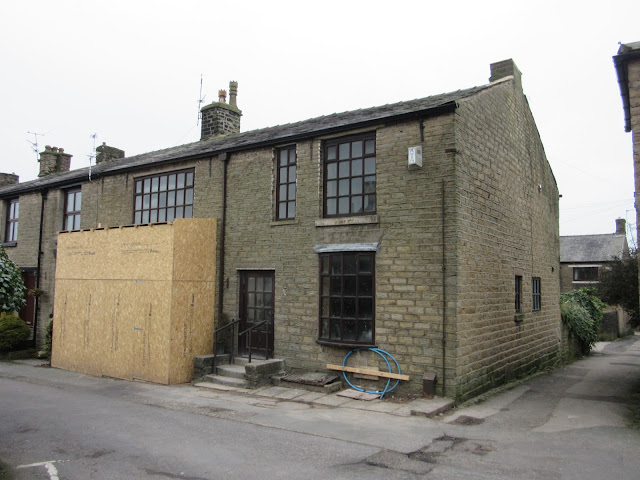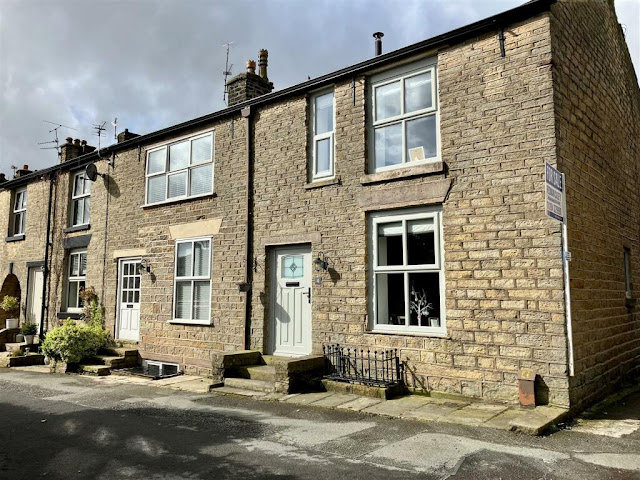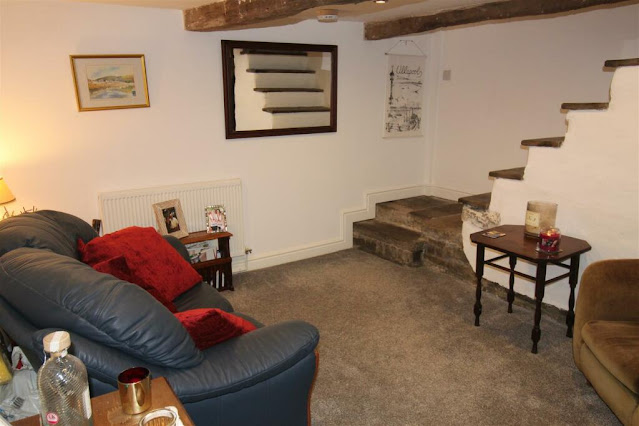Address: 4, Nelson Street, Horwich
Opened in the mid 1800s the Sawyers' Arms was the end-terraced property of the club houses on Nelson Street. Pictured above in 2018 the property was under renovation and has been used for residential purposes for many years now since its closure in the 1950s.
The property dates back to before the 1845 map below, which clearly shows the club houses on Nelson Street, the end cul-de-sac on the right off Church Street. Its name probably refers to the longest standing landlord, William Lawton who was a Sawyer and Beerseller.
 |
| 1845 |
 |
| Duncan Street Club Houses |
The Lawtons lived at 4 Nelson Street for around half a century, having moved in sometime in the 1850s and staying until at least 1905, Sarah taking over the reins behind the bar following William Jnr's death in 1890.
 |
| 1861 Census William Lawton Beerseller & Sawyer |
 |
| 1869 Slater's Directory |
 |
| 1871 Census William Lawton Beerseller |
 |
| 1876-77 Post Office Directory |
Marriage: 3 Apr 1878 Horwich Chapel, Horwich, Lancashire, England
Robert Lawton - 29, Quarryman, Bachelor, Horwich
Ann Marsden - 27, Doubler, Spinster, Horwich
Groom's Father: William Lawton, Inn Keeper
Bride's Father: John Marsden, Dyer
Witness: John Brotherton; Ann Brotherton
Married by Banns by: H.S. Pigot, Vicar
Register: Marriages 1854 - 1881, Page 212, Entry 424
Source: LDS Film 2113122
Robert Lawton - 29, Quarryman, Bachelor, Horwich
Ann Marsden - 27, Doubler, Spinster, Horwich
Groom's Father: William Lawton, Inn Keeper
Bride's Father: John Marsden, Dyer
Witness: John Brotherton; Ann Brotherton
Married by Banns by: H.S. Pigot, Vicar
Register: Marriages 1854 - 1881, Page 212, Entry 424
Source: LDS Film 2113122
 |
| 1881 Census William Lawton Beerseller |
 |
| Nelson Street Club Houses |
Bolton News 8th & 15th June 2016
Horwich and Wallsuches' history revealed
Looking at Horwich today it is hard to imagine that it was once a tiny hamlet.
Back in 1777 the Ridgways moved their bleach works from Bolton to Horwich and this paved the way for Horwich to grow into a thriving village during the 19th century — before the arrival of the Railway Works.
The first workers' houses were built in Horwich in 1801 and they were, and still are, known as the "club houses" — because the Ridgways formed a building club to help their workers buy or rent their own homes.
Horwich Heritage has an exhibition entitled "Wallsuches and the Club Houses" which opens at the Heritage Centre on Saturday June 25.
Today Arcon Village occupies the Wallsuches spot where the bleach works and houses were built 200 years ago.
Stuart Whittle, chairman of Horwich Heritage, has produced a fascinating insight into the past of the town, dating back to 1620.
Here we look at the early years of Horwich followed by more in forthcoming issues of Looking Back.
In 1620, explains Stuart, Horwich was just a very small settlement with only 48 tenant pastures — the main activity being subsistence farming with the wealthier farms being up on the moors above Horwich where hand loom weaving supplemented the meagre family income.
"Cloth was washed and bleached in the local streams running down off the moor and although this activity was very small scale it contained the elements that would lead to the transformation of these tenant pastures into significant bleaching operations within the next 100 to 150 years," says Stuart.
Thomas Hampson, in his history of Horwich, describes the hamlet in the 1700s as being a bleak and cheerless place.
But it did, however, possess the essential ingredient for what would initially create a local bleaching industry and then provide the means of motive power — water and plenty of it.
"Bleaching at that time used the old "atmospheric" system where cloth was washed in sour milk and urine and stretched out across fields on tenterhooks to dry, explains Stuart.
"Something much more organised and efficient was necessary to make it a substantial industry.
"The pivotal moment was the introduction of chemical bleaching using chlorine and other chemicals.
"And there was one family in Bolton who recognised the importance of this breakthrough — the Ridgways. By doing so they transformed the fortunes of the humble hamlet of Horwich," adds Stuart.
Brothers John and Thomas Ridgway were, originally, bleachers at Dog Brow in Bolton which is now the site of the market hall. A fire at their premises in 1775 prompted them to look for a larger site and they took out a 99 year lease on land at Wallsuches in Horwich in 1777.
Horwich at this time only had 365 people.
No one knows how the area got its name, remarks Stuart, but it is said it was derived from the way the Ridgways issued their building instructs: "We'll have another wall at such and such tomorrow." But Stuart says: "It's not an entirely convincing explanation."
Within three years the bleach works had six water wheels driving the machinery.
The company, which now included sons Joseph and Thomas, was one of the first to introduce Boulton and Watt steam engines to replace water power.
The Ridgways seems to have a good attitude towards their workers although dishonestly was not tolerated and there is a record of one of their workers, John Boothman, being transported to Australia for stealing £20 in 1802 and James Holland was one of a number of men executed in the Bolton area for stealing 30 yards of cloth.
The family assisted with the building of the Parish Church School in 1793 and the re-building of the Parish Church in 1830.
A building club was set up by the family in 1802 so that employees could construct their own homes — this attractive area of stone terraces directly opposite the Parish Church is still known today as the "Club Houses".
The Black Bull was used as the meeting place of various bodies. Joseph Ridgway became chairman of the local magistrates' bench and the family was instrumental in bringing the penny post to Horwich in 1815.
Wallsuches was like a village in its own right with buildings and cobble stone roads surrounded by large reservoirs, quarries and mines.
"For more than 200 years the Wallsuches clock and bell have stood as proud symbols of the legacy of bleaching on the site and it is fitting that they should form part of the new residential scheme now known as Arcon Village.
"Wallsuches was, in fact, the heart of Horwich throughout the 19th century."
At its height the bleach works was a very busy place employing hundreds of people and employees would regularly work until two or three in the morning — after which they would lie down on a bale of cloth to snatch few hours sleep before beginning work again at 6am, explains Stuart.
"The Ridgways were good employers for their time, despite employing child labour in the early years, who overall treated their workforce well and were concerned for their welfare.
"They even continued to pay their workers when there was little work during the cotton famine of the 1860s brought about by the American Civil War," he says.
Pay day at Wallsuches was an extremely important occasion both for the employee, his family and the community. By 1830 "such days" as they were known came about once a month and the whole community would come out to play, "dressing up, holding events, meetings and generally celebrating," says Stuart.
Wallsuches was the "heart" of Horwich throughout the 19th century explains Horwich Heritage chairman Stuart Whittle who has researched the area.
"Without it and the Ridgways the town would not have developed in the way it did," he says.
At its height the bleachworks was a very busy place employing hundreds of people and employees would regularly work until two or three in the morning after which they would lie down on a bale of cotton to snatch a few hours sleep before beginning work again at 6am.
"This would mean that for long periods male employees only saw their women folk when they brought food to the works.
"Despite the long hours and dangerous conditions jobs were secure and work plentiful and there is plenty of evidence of three or four generations of a family working there.
"The Ridgways were good employers for their time (despite employing child labour in the early years) who, overall, treated their workforce well and were concerned for their welfare.
"They even continued to pay their workers when there was little work during the cotton famine of the 1860s brought about by the American Civil War."
Pay day at Wallsuches was an important occasion with the whole community dressing up and celebrating. Once payment became more frequent towards the middle of the 19th century this practice began to die out, explains Stuart.
Right from their early years the Ridgways were anxious to provide accommodation for their workforce the majority of whom were coming from nearby areas such as Deane, Westhoughton, Blackrod, Adlington and Chorley.
They were also keen that these workers should own their own homes and set up a building scheme.
Workers joined the building club in order to qualify for a new house and these were then called club houses.
The scheme started in 1801, explains Stuart. "Because the houses weren't numbered until the 1870s it is difficult to work out who lived where from the Parish Records. It would appear the first ones were built opposite the Parish Church followed by the individual streets running as right angles," says Stuart.
A second club house scheme was started in 1829 and as the area developed a shop and a pub (The Horseshoe) opened in Church Street as well as the Sawyers' Arms in Nelson Street.
Thanks to the Ridgways and their rapidly developing bleachworks a postal service arrived in Horwich in the early 1800s and the first post office in Horwich opened in Church Street in 1807.
Not surprisingly records reveal that the majority of residents had occupations directly related to the bleaching industry including spinners, weavers, crofters and finishers but there were supporting skills including stonemasons, plumbers and blacksmiths.
Many Horwich residents can trace their ancestry back to the club houses and the bleachworks.
 |
| William Lawton Probate 1890 |
 |
| 1891 Census Sarah Lawton Beerseller |
 |
| 1901 Census Sarah Lawton Beerseller |
 |
| 1905 Kelly's Directory |
 |
| 1911 Census Robert Winnard Beer Seller |
 |
| Cellar entrance to the rear of the Sawyers' Arms |
 |
| 1947 Map |
The following photos show the building as a residential property, which was on the market in 2023.











the 4th pic, your photo of Nelson street Clubhouses is actually Duncan Street. The house with the steps and railings is #3 Duncan Street - my Dad built those steps in the late 1960's
ReplyDelete